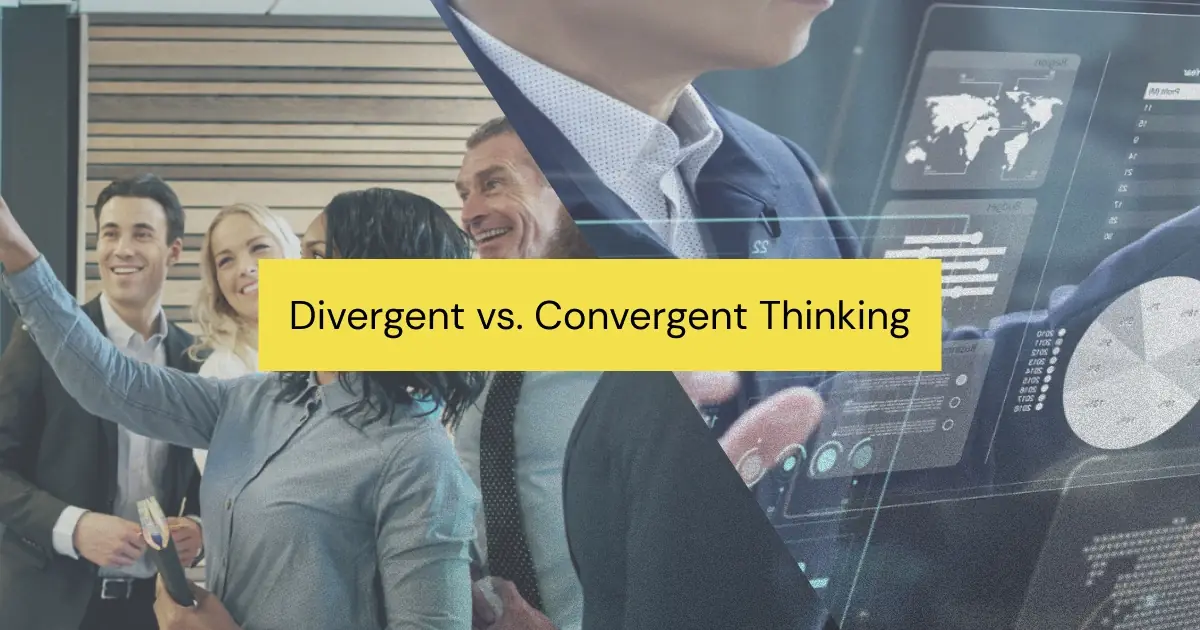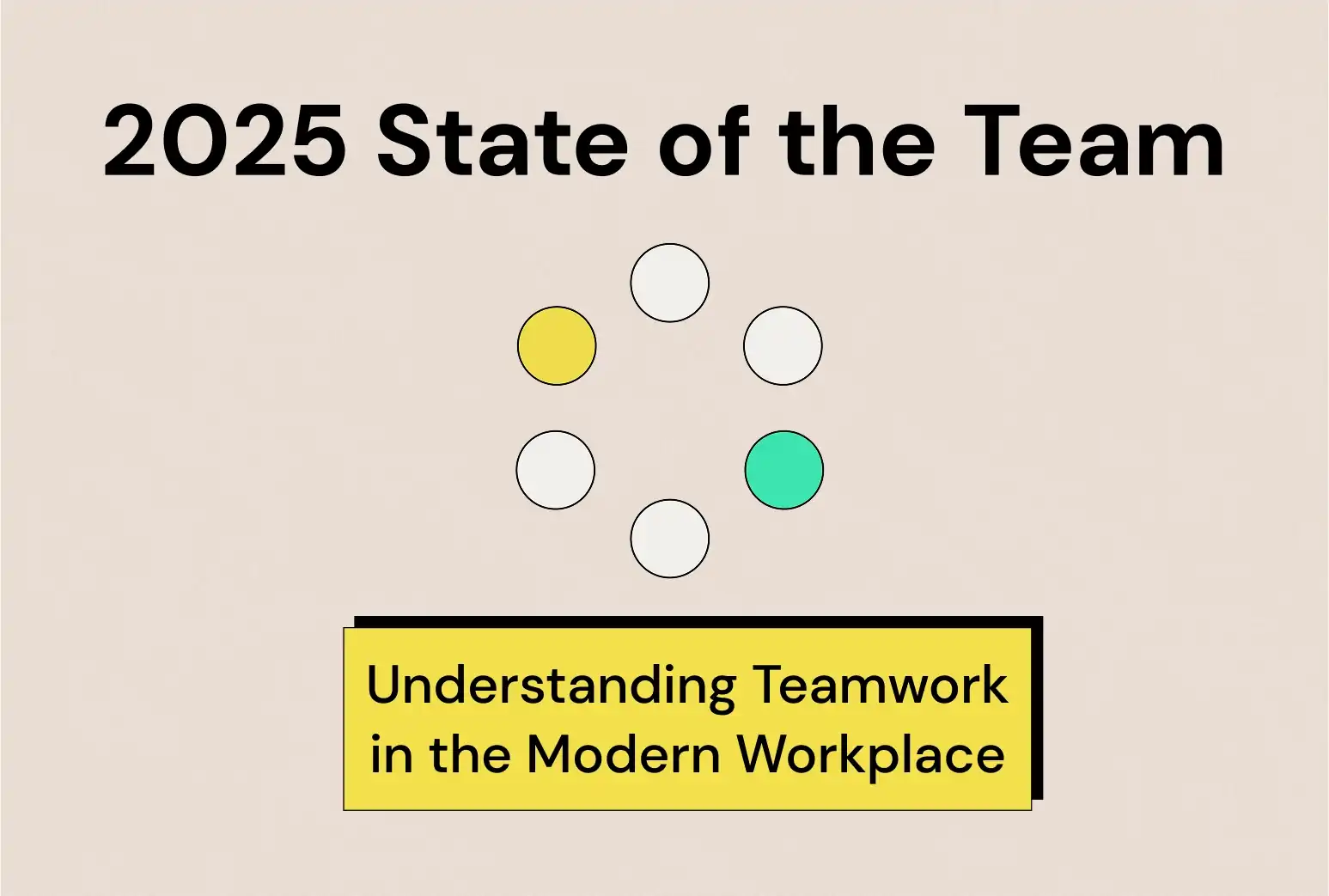In today’s fast-paced professional world, decision-making is crucial. Understanding convergent vs. divergent thinking can give your team a significant edge.
Convergent thinking focuses on finding a single, best solution. It’s methodical and logical, perfect for tasks requiring precision and accuracy. Divergent thinking, on the other hand, encourages creativity and multiple solutions. It’s ideal for brainstorming and innovation.
Imagine your product team at a tech company facing a challenge. Using convergent thinking, they analyze data and zero in on the most efficient solution. Alternatively, with divergent thinking, they explore various creative ideas, sparking innovation.
Both thinking styles have their place. Knowing when to use each can enhance your team’s performance. This blog will delve into convergent thinking vs. divergent thinking, offering practical tips and real-world examples. We’ll explore how to balance these approaches for optimal results.
By mastering these thinking styles, you can lead your team to greater success. Let’s dive into the world of convergent and divergent thinking and unlock your team’s full potential.
{{inline-cta}}
What is Convergent Thinking?
Convergent thinking is about narrowing down options to find the best solution. It’s logical, systematic, and focused on efficiency. In a professional setting, this approach helps teams make precise decisions and solve problems effectively.
Characteristics of Convergent Thinking:
- Logical: Convergent thinking follows a clear, step-by-step process. It relies on logic and structured methods to arrive at the best solution. This logical approach ensures that every step is deliberate and well-thought-out, minimizing the chances of error.
- Focused: This thinking style zeroes in on finding the single best answer to a problem. It eliminates distractions and irrelevant information, allowing the team to concentrate on the most effective solution. The focus is on precision and accuracy, ensuring that the chosen solution is the best fit for the problem at hand.
- Analytical: Convergent thinking relies heavily on data and evidence. It involves analyzing available information, evaluating options based on specific criteria, and making decisions grounded in facts. This analytical approach ensures that decisions are well-supported and justifiable, making it easier to implement solutions with confidence.
Convergent Thinking Examples in the Workplace:
- Product Development: When launching a new product, your team analyzes market data to identify the most promising features. They focus on what will appeal to your target audience, ensuring the product meets specific needs.
- Marketing Campaigns: Your marketing team uses convergent thinking to design a campaign. They study past data, identify what worked, and apply those insights to create a focused strategy.
- Budget Planning: Finance teams use this approach to allocate resources efficiently. They analyze financial data, prioritize essential expenses, and ensure the budget aligns with company goals.
Understanding the strengths of convergent thinking can enhance decision-making processes. By applying this approach, your team can tackle challenges with precision and clarity. In the next section, we’ll explore divergent thinking and how it complements convergent thinking in a balanced approach to problem-solving.
What is Divergent Thinking?
Divergent thinking is about generating many possible solutions. It’s creative, open-ended, and encourages out-of-the-box ideas. In a professional setting, this approach helps teams innovate and explore new possibilities.
Characteristics of Divergent Thinking:
- Creative: Divergent thinking thrives on creativity and imagination. It encourages team members to think beyond conventional solutions and explore innovative ideas. This creative approach fosters a culture of originality and inventiveness.
- Open-Ended: This thinking style embraces multiple possibilities. It doesn’t limit the team to a single solution but opens the door to various potential answers. The open-ended nature of divergent thinking allows for flexibility and adaptability in problem-solving.
- Exploratory: Divergent thinking involves exploring different perspectives and ideas. It encourages brainstorming and the free flow of thoughts without immediate judgment or criticism. This exploratory approach helps uncover new opportunities and approaches that might not have been considered otherwise.
Divergent Thinking Examples in the Workplace:
- Brainstorming Sessions: During brainstorming sessions, your tech team uses divergent thinking to generate a wide range of ideas for a new feature. They don’t limit themselves to what seems immediately feasible, allowing for more innovative solutions.
- Creative Marketing Strategies: Your marketing team employs divergent thinking to develop unique campaign ideas. By exploring various creative angles, they come up with fresh and engaging strategies that stand out in the market.
- Innovative HR Solutions: HR teams use divergent thinking to find new ways to improve employee engagement and satisfaction. They explore different programs and initiatives, considering a variety of approaches to enhance the workplace culture.
Understanding the power of divergent thinking can drive innovation and creativity within your team. By encouraging this approach, you can foster an environment where new ideas flourish. In the next section, we’ll compare convergent thinking vs. divergent thinking and discuss how to balance these approaches for optimal results.
Convergent vs. Divergent Thinking: Key Differences
Understanding the differences between convergent and divergent thinking is crucial for effective problem-solving. Each thinking style has its strengths and is suited to different situations.
Comparing Divergent vs. Convergent Thinking: Comparison Table
| Aspect |
Divergent Thinking |
Convergent Thinking |
| Approach |
Creative and exploratory |
Logical and systematic |
| Goal |
Generate multiple possible solutions |
Find the single best solution |
| Process |
Embraces open-ended brainstorming |
Follows a step-by-step method |
| Application |
Innovation and idea generation |
Problem-solving with precision |
| Decision-Making |
Based on creativity and imagination |
Based on data and evidence |
| Outcome |
Diverse and varied |
Focused and specific |
Situational Uses:
Knowing the right time to apply divergent thinking vs. convergent thinking can make your team more effective.
When to Use Convergent Thinking:
- Decision-Making: When making critical decisions that require accuracy and reliability, such as budget allocation or project planning.
- Problem-Solving: When solving problems that need precise solutions, like troubleshooting technical issues or optimizing processes.
- Evaluation: When assessing options to determine the most effective one, such as selecting a vendor or choosing a marketing strategy based on performance data.
When to Use Divergent Thinking:
- Idea Generation: During brainstorming sessions to come up with a wide range of ideas for new products, services, or marketing campaigns.
- Creative Solutions: When seeking innovative solutions to complex problems, encouraging out-of-the-box thinking and exploring various possibilities.
- Strategic Planning: When developing long-term strategies, allowing for the consideration of multiple scenarios and potential opportunities.
Examples of both Convergent and Divergent Thinking in Action:
Each method of thinking can be relevant for tackling different parts of the same overall challenge. Here are a few examples:
Scenario 1: Product Launch Strategy
- Convergent Thinking: Your product team analyzes customer feedback and market data to choose the best features to highlight in the launch. They focus on what will drive the most sales and meet customer needs.
- Divergent Thinking: In the brainstorming phase, the team explores all possible features and enhancements, considering even the most unconventional ideas to ensure no potential innovation is overlooked.
Scenario 2: Solving a Customer Service Issue
- Convergent Thinking: The customer service team identifies the main issue through data analysis and implements a targeted solution to resolve the problem efficiently.
- Divergent Thinking: Initially, the team brainstorms various ways to improve overall customer satisfaction, generating a range of ideas that could prevent similar issues in the future.
Benefits of Combining Both Thinking Styles
Combining convergent and divergent thinking can unlock your team’s full potential. Each approach has unique strengths that, when used together, can lead to more effective problem-solving and innovation.
Synergy in Teams:
Using both thinking styles creates a balanced approach. Divergent thinking allows teams to explore various possibilities and generate creative ideas. Convergent thinking then refines these ideas, selecting the most viable and effective solutions. This synergy ensures that teams do not just generate ideas but also implement the best ones.
Case Study: A Real-World Example
Consider a tech company developing a new product. Initially, the team engages in divergent thinking, brainstorming various features and design concepts. They explore creative possibilities without restriction. Once they have a range of ideas, they switch to convergent thinking. They analyze customer data, market trends, and technical feasibility to narrow down the best features to include in the product. This combined approach results in a product that is both innovative and market-ready.
Expert Opinions:
Experts agree that balancing both thinking styles leads to better outcomes. According to innovation consultant and author, Tim Brown, “Integrating divergent and convergent thinking helps teams move from imagining possibilities to implementing practical solutions.” This balance is crucial in today’s fast-paced business environment where creativity and efficiency must go hand in hand.
Practical Tips for Managers:
Fostering Convergent Thinking:
- Structured Meetings: Conduct meetings with clear agendas to keep discussions focused.
- Data-Driven Decisions: Use data and evidence to guide decision-making processes.
- Prioritize: Encourage the team to prioritize tasks and focus on the most critical issues.
Encouraging Divergent Thinking:
- Brainstorming Techniques: Use methods like mind mapping or the SCAMPER technique to spark creativity.
- Create a Safe Space: Encourage open discussions where all ideas are welcomed and considered.
- Diverse Teams: Build teams with diverse backgrounds and perspectives to enhance creative thinking.
Balancing Both Convergent and Divergent Thinking:
- Rotate Roles: Rotate team roles regularly to ensure members experience both creative and analytical tasks.
- Scheduled Creativity Sessions: Set aside specific times for creative brainstorming, separate from routine meetings.
- Feedback Loop: Implement a feedback loop where creative ideas are regularly reviewed and refined using analytical thinking.
By integrating both convergent and divergent thinking, managers can harness the full range of their team’s abilities. This balanced approach not only fosters innovation but also ensures that creative ideas are effectively implemented, leading to better results and a competitive edge in the market. In the next section, we’ll explore specific tools and techniques to support both thinking styles in your team.
Tools and Techniques
Utilizing the right tools and techniques can enhance both convergent and divergent thinking within your team. Here are some practical methods to support each thinking style and achieve a balanced approach.
Convergent Thinking Tools:
- SWOT Analysis: This tool helps teams identify strengths, weaknesses, opportunities, and threats. It focuses on analyzing data and making informed decisions based on clear criteria.
- Decision Matrices: These are used to evaluate and prioritize options based on specific factors. By assigning weights to each factor, teams can systematically determine the best choice.
- Flowcharts: Visualize processes and decision points to identify the most efficient path. Flowcharts help teams follow a logical sequence and avoid unnecessary steps.
Divergent Thinking Tools:
- Mind Mapping: This technique allows teams to visually organize ideas around a central concept. It encourages free association and the exploration of various branches of thought.
- SCAMPER Technique: SCAMPER stands for Substitute, Combine, Adapt, Modify, Put to another use, Eliminate, and Reverse. It prompts teams to look at problems from different angles and generate innovative solutions.
- Brainstorming Sessions: Structured brainstorming sessions with no immediate judgment or criticism can spark creativity. Encourage all team members to contribute ideas freely.
Tech Tools to Support Both Thinking Styles:
- Trello: This project management tool can be used to organize tasks and ideas. Trello boards allow teams to visually track progress and prioritize tasks effectively.
- Miro: A digital whiteboard that supports both brainstorming and project planning. Miro enables teams to collaborate in real-time, whether they are generating ideas or refining them.
- Asana: Another project management tool that helps teams coordinate and manage tasks. Asana’s structured approach is ideal for convergent thinking, while its flexibility supports divergent idea generation.
Integrating Tools for Balanced Thinking:
- Combine Techniques: Use mind mapping during brainstorming sessions to generate ideas (divergent thinking), then apply SWOT analysis or decision matrices to refine and choose the best solutions (convergent thinking).
- Regular Workshops: Host regular workshops where teams practice both thinking styles. Start with creative exercises to spark divergent thinking, followed by structured sessions to focus on convergent thinking.
- Feedback Mechanisms: Implement feedback loops where ideas generated through divergent thinking are regularly reviewed and analyzed using convergent thinking tools. This ensures continuous improvement and refinement.
By equipping your team with the right tools and techniques, you can foster both creative and analytical thinking. This balanced approach not only enhances problem-solving but also drives innovation and efficiency. In the final section, we’ll summarize the key points and provide actionable steps for managers to implement these strategies in their teams.
Conclusion
Understanding and balancing convergent and divergent thinking can transform your team’s problem-solving and innovation capabilities. By integrating these thinking styles, you can enhance both creativity and precision in your team’s work.
{{inline-cta}}
Summary of Key Points:
- Convergent Thinking: Focuses on finding the best solution through logical, systematic, and data-driven methods. It’s ideal for decision-making, problem-solving, and evaluation.
- Divergent Thinking: Encourages generating multiple solutions through creative, open-ended, and exploratory approaches. It’s perfect for brainstorming, innovation, and strategic planning.
- Balancing Both: Using both thinking styles in tandem leads to better outcomes. Convergent thinking refines and implements the creative ideas generated through divergent thinking.
Actionable Steps for Managers:
1. Evaluate Your Team’s Current Approach:
- Assess whether your team leans more towards convergent or divergent thinking.
- Identify areas where the opposite thinking style could add value.
2. Implement Regular Brainstorming Sessions:
- Schedule regular sessions dedicated to divergent thinking. Encourage team members to explore new ideas without immediate criticism.
3. Incorporate Structured Decision-Making:
- After brainstorming, use convergent thinking tools like SWOT analysis or decision matrices to evaluate and prioritize ideas.
4. Provide Training and Resources:
- Offer training on both thinking styles and introduce relevant tools and techniques. Ensure your team understands how and when to apply each approach.
5. Create a Balanced Culture:
- Foster a culture that values both creativity and analytical thinking. Encourage open discussions and diverse perspectives.
6. Monitor and Adjust:
- Regularly review the effectiveness of your team’s approach. Make adjustments as needed to maintain a healthy balance between convergent and divergent thinking.
Start by evaluating your team’s current thinking styles. Implement regular brainstorming sessions and structured decision-making processes. Provide the necessary training and tools to foster a balanced culture. By taking these steps, you can unlock your team’s full potential and drive better outcomes in your projects.
Further Reading:
For more insights into convergent and divergent thinking, consider exploring the following resources:
Balancing convergent and divergent thinking is a powerful strategy for any manager. By embracing both approaches, you can lead your team to greater innovation, efficiency, and success.




.png)









































